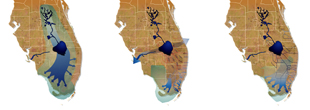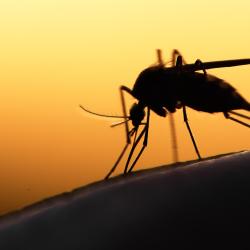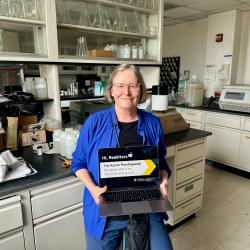National Academies Report Co-authored by UMD Scientist Offers Hope, Climate Change Concerns for Everglades Restoration Project
Fernando Miralles-Wilhelm led report committee’s climate change research efforts
The Florida Everglades’ cypress swamps, mangrove trees and “river of grass” cover the southern 20 percent of the state, making it the largest freshwater wetland in the United States. Since people started draining the wetlands for habitation and agriculture in the 1800s, about 50 percent of the Everglades have been lost, resulting in less available freshwater for residents, droughts and flooding.
 As a result, Congress authorized in 2000 the Comprehensive Everglades Restoration Plan (CERP), a multibillion-dollar project created to “restore, preserve, and protect the South Florida ecosystem while providing for other water-related needs of the region, including water supply and flood protection.” The CERP planned an extensive number of projects with the overarching goal of restoring water flow to pre-drainage patterns while accounting for the needs of current residents.
As a result, Congress authorized in 2000 the Comprehensive Everglades Restoration Plan (CERP), a multibillion-dollar project created to “restore, preserve, and protect the South Florida ecosystem while providing for other water-related needs of the region, including water supply and flood protection.” The CERP planned an extensive number of projects with the overarching goal of restoring water flow to pre-drainage patterns while accounting for the needs of current residents.
According to a new National Academies report on the project’s progress, the CERP has accomplished positive results—more water flows through the Everglades system than when the restoration began, and short of extreme conditions the new system performs better in the face of rain or drought. However, the CERP needs to account for climate change to achieve projected levels of water flow and extreme weather tolerance, according to the report.
“You can think of the CERP as a replumbing of the Everglades water system, and if you want the plumbing to work right, you have to account for how climate change affects the amount of water in the system’s pipes—its wetlands, canals and reservoirs,” said Fernando Miralles-Wilhelm, a co-author of the report and a professor of atmospheric and oceanic science at the University of Maryland and interim director of UMD’s Earth System Science Interdisciplinary Center.
The report recommends specific actions be taken to update the CERP, such as performing new assessments and analyses, and developing planning and management models that take climate change into account. The goal is to adjust plans for future canal and reservoir engineering projects to account for climate change before they are built.
“Adjustments are necessary because climate change leads to both a rise in sea levels and changes in rainfall patterns,” explained Miralles-Wilhelm. “The sea is salt water and the rain is freshwater. The combination leads to dramatic changes in the distribution of freshwater throughout the Everglades wetlands. This impacts not only the ecosystem, but also the ability of the canals and reservoirs to provide adequate protection against floods and droughts in the increasingly urbanizing south Florida environment.”
 Miralles-Wilhelm’s scientific expertise and personal background drew him to the committee of 14 independent experts who authored the latest progress report, which is produced biannually. Not only does his scientific research focus on the way water moves through complex ecosystems such as wetlands, he also lived in Miami for over 10 years and held faculty positions at Florida International University and the University of Miami.
Miralles-Wilhelm’s scientific expertise and personal background drew him to the committee of 14 independent experts who authored the latest progress report, which is produced biannually. Not only does his scientific research focus on the way water moves through complex ecosystems such as wetlands, he also lived in Miami for over 10 years and held faculty positions at Florida International University and the University of Miami.
At Florida International University, Miralles-Wilhelm published a paper in 2011 in the journal Ecohydrology titled “Possible climate change impacts on the hydrological and vegetative character of Everglades National Park, Florida.” In this paper, he and his co-authors found that mean annual rainfall, and therefore freshwater availability, in the Everglades can be expected to decrease with climate change. The paper recommended that future efforts to restore the Everglades landscape take into account the forecasted influences of climate change.
“I think the Academies wanted someone who was a little bit of an outsider to Florida politics but who understood the issues surrounding the Everglades and was an expert in hydrology,” said Miralles-Wilhelm.
During the two years the committee spent preparing the report, Miralles-Wilhelm took several trips to the Everglades to inspect the existing and planned canals and reservoirs. He also participated in a series of intense meetings with stakeholders—state agencies, NGOs, private companies, local municipal governments, Florida and U.S. government officials, the Army Corps of Engineers, and the National Park Service.
“We reviewed the science being used for restoration and examined whether that science was sound and whether every effort was being made to incorporate the latest science,” said Miralles-Wilhelm, who led the committee’s climate change-related research efforts. “That’s when we realized climate change had not been considered in the original CERP and may be the reason why the system cannot handle increasing conditions of drought or flooding.”
In addition to the scientific and engineering work that lies ahead to incorporate the effects of climate change, financing the CERP remains a challenge. The report warns that less than 20 percent of CERP projects have been funded to date, and it could take 100 years to complete the CERP at the current rate of funding, during which time the Everglades would decline further. The report notes that completing the CERP in 50 years, as estimated in a 2014 Congressional Research Service report, would require “substantial additional investment.”
Miralles-Wilhelm believes a top priority for tackling these challenges is to make the economic case for Everglades restoration as impacted by climate change.
“If you look at the economic activity of South Florida, the big three are tourism, agriculture and urban development. Climate change hits all of them,” said Miralles-Wilhelm. “I don’t think it’s a huge leap to say that improving the Everglades ecosystem will improve each of these economic sectors, but I do think that convincing the average citizen, business person and policymaker remains to be done. Otherwise people will say ‘this is another climate change project’ when it’s actually geared toward the social and economic development of the state.”
For his part, Miralles-Wilhelm will continue to contribute what he can to help restore the Everglades—he has already agreed to work on the 2018 report.
###
The report, “Progress Toward Restoring the Everglades: The Sixth Biennial Review, 2016,” Committee on Independent Scientific Review of Everglades Restoration Progress; Water Science and Technology Board; Board on Environmental Studies and Toxicology; Division on Earth and Life Studies; National Academies of Sciences, Engineering, and Medicine, was prepublished online in December 2016 by the National Academies Press.
This work was supported by the Department of the Army (Cooperative Agreement No. W912EP-04-2-0001), the U.S. Department of the Interior and the South Florida Water Management District. The content of this article does not necessarily reflect the views of these organizations.
The research paper, “Possible climate change impacts on the hydrological and vegetative character of Everglades National Park, Florida,” M. Jason Todd, R. Muneepeerakul, F. Miralles-Wilhelm, A. Rinaldo, and I. Rodriguez-Iturbe, was published April 29, 2011, in the journal Ecohydrology.







